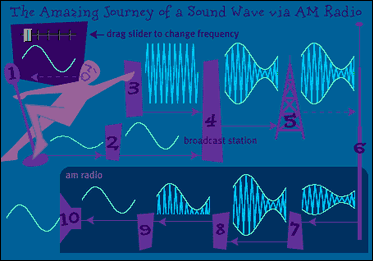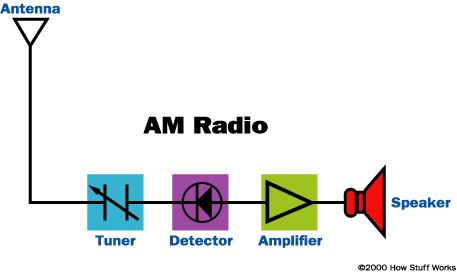How radio waves work
Microphone
Amplifier
Carrier
Wave Generator
Modulator
Transmitting
Antenna
Receiving
Antenna
Amplifier
Demodulator
Filter
Speaker

How radio waves work
Microphone
Amplifier
Carrier
Wave Generator
Modulator
Transmitting
Antenna
Receiving
Antenna
Amplifier
Demodulator
Filter
Speaker

Sound vibrations leave the singer's mouth. The higher the pitch of the sound, the higher the frequency, or number of vibrations in a given amount of time. The sound enters the microphone, where it is converted into a weak electrical signal.
The weak signal from the microphone is amplified. Notice how the incoming signal is flatter than the outgoing signal. This additional height, or amplitude, indicates that the signal has more power. Notice, too, that the frequency of the incoming and outgoing signals are the same.
The Wave Generator creates a high-frequency radio signal. The frequency of this signal is many times greater than the frequency of the audio wave. This signal will "carry" the audio signal over the air.
The carrier signal amplitude (height) is altered, or modulated, to reflect changes in the audio signal's amplitude. Notice how a copy of the audio wave is visible on the upper and lower halves of the carrier wave.
The radio signal travels to the antenna. The signal creates a corresponding electromagnetic field -- a radio wave. This radio wave moves outward in all directions. To learn how the electromagnetic field is created, go to How is a Radio Wave Emitted?
An antenna picks up the the radio wave. If the antenna is far from the transmitter, the signal is very weak.
The weak signal is amplified.
The radio signal is cut in half. Since both halves of the signal hold the same audio information, only half of the signal is needed.
The signal is fed through a filter. This removes the carrier wave from the signal. What remains is the audio signal.
The audio signal causes the radio speaker's diaphragm to vibrate, which creates sound waves. A sound wave equivalent to the singer's voice radiates from the speaker.
